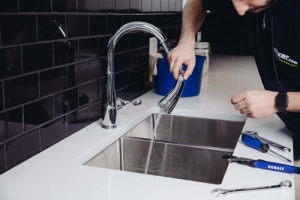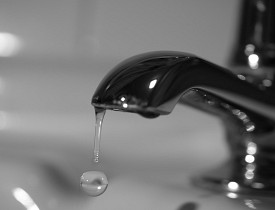Discovering the Significance of Fixing a Dripping Faucet
Discovering the Significance of Fixing a Dripping Faucet
Blog Article
Almost everyone is bound to have their personal way of thinking when it comes to 4 Common Reasons for a Leaky Faucet.

Trickling faucets could seem like a small inconvenience, however their influence exceeds simply the nuisance of the sound. From drainage to incurring unnecessary economic prices and health threats, ignoring a leaking faucet can cause various consequences. In this write-up, we'll look into why it's important to address this typical household problem immediately and successfully.
Waste of Water
Ecological Influence
Dripping taps contribute substantially to water wastefulness. According to the Epa (EPA), a single tap dripping at one drip per secondly can squander greater than 3,000 gallons of water per year. This not just pressures water resources however also affects environments and wildlife depending on them.
Step-by-Step Guide to Taking Care Of a Dripping Tap
Tools Called for
Before trying to take care of a dripping tap, collect the essential devices, consisting of an adjustable wrench, screwdrivers, replacement components (such as washers or cartridges), and plumber's tape.
Typical Faucet Issues and Their Solutions
Recognize the type of faucet and the details concern causing the drip. Common troubles include worn-out washers, rusty valve seats, or defective O-rings. Describe producer directions or on the internet tutorials for step-by-step assistance on fixings.
Financial Expenses
Increased Water Expenses
Beyond the ecological influence, dripping taps can pump up water expenses significantly. The accumulated wastage with time converts into higher utility costs, which could have been avoided with timely repair work.
Potential Home Damage
Moreover, long term trickling can bring about damage to fixtures and surface areas bordering the faucet. Water buildup can trigger staining, rust, and also architectural concerns if left ignored, causing added repair expenses.
Health and wellness Problems
Mold and Mold Development
The continuous existence of moisture from a dripping tap develops a perfect environment for mold and mold development. These fungi not just endanger interior air quality but additionally present wellness dangers, specifically for people with breathing problems or allergies.
Waterborne Conditions
Stagnant water in dripping faucets can end up being a breeding ground for bacteria and other virus, increasing the threat of waterborne conditions. Pollutants such as Legionella microorganisms grow in stagnant water, potentially resulting in major diseases when ingested or breathed in.
Do it yourself vs. Specialist Repair service
Advantages and disadvantages of Do It Yourself Repair Service
While some might attempt to repair a trickling faucet themselves, do it yourself repair services feature their own collection of challenges. Without correct expertise and tools, DIY attempts can aggravate the issue or bring about insufficient repair services, lengthening the trouble.
Advantages of Employing an Expert Plumber
Hiring an expert plumber ensures that the underlying reason for the trickling faucet is addressed effectively. Plumbing technicians possess the proficiency and devices to diagnose and fix tap concerns efficiently, saving time and lessening the danger of further damage.
Environmental Duty
Private Payment to Preservation
Taking responsibility for dealing with dripping taps aligns with broader efforts towards water conservation and ecological sustainability. Every person's actions jointly make a considerable influence on preserving precious sources.
Lasting Living Practices
By focusing on punctual repairs and taking on water-saving habits, individuals contribute to lasting living techniques that benefit both existing and future generations.
Safety nets
Regular Maintenance Tips
To stop dripping faucets, execute routine maintenance such as cleaning up aerators, checking for leakages, and changing damaged components quickly. In addition, take into consideration installing water-saving gadgets or upgrading to a lot more efficient fixtures.
Value of Prompt Repairs
Addressing trickling taps as soon as they're noticed protects against additional water wastage and prospective damage, eventually saving both water and cash over time.
Effect On Building Worth
Assumption of Well-Maintained Property
Maintaining a home in good condition, consisting of addressing maintenance issues like trickling faucets, improves its perceived value and worth amongst prospective purchasers or occupants.
Impact on Resale Value
Features with well-maintained plumbing fixtures, consisting of taps, command greater resale worths in the realty market. Addressing dripping faucets can add to a favorable impression during residential property examinations and settlements.
Final thought
Attending to a trickling faucet surpasses simple comfort; it's a necessary action towards saving water, lowering financial costs, and guarding wellness and home. Whether via DIY repairs or expert support, doing something about it to fix leaking faucets is a tiny yet impactful means to advertise accountable stewardship of sources and add to a much healthier, extra sustainable future.
How to Fix a Leaky Faucet: Step-by-Step Repair Guide
A leaky faucet may seem like a simple annoyance, but if it's not fixed promptly, that leak could cost hundreds to potentially thousands. From water damage to mold, mildew, and high water bills, even a tiny leak can be catastrophic if left unattended. Damage like this can even affect the overall value of your home, so it's important to take the right approach for leaky faucet repair. You may need the help of a plumber in some cases, but we've got a few tips you can try on how to fix a leaky faucet before calling the pros.
Four Faucet Types
When you're learning how to fix a leaky faucet, the first step is knowing what kind of faucet you're working with! There are four common types.
Cartridge Faucets
Cartridge faucets come in one- or two-handled varieties. In one-handled cartridge faucets, hot and cold water combines in a single cartridge. In the two-handled versions, hot and cold water are controlled separately and mixed in the faucet.
Ball Faucets
Ball faucets have a single lever you push up and down to adjust the pressure and rotate to change the temperature. A slotted metal ball controls the amount of water allowed into the spout.
Compression Washer Faucets
They're the oldest type of faucet, but they're still used in many homes — especially older ones. Compression faucets have two separate handles that, when turned, raise or lower the washer that seals a water valve. This valve stops water from flowing through the faucet when it is turned off.
Disc Faucets
Disc faucets rarely need to be repaired due to their maintenance-free design. The water flow is controlled by two discs — the upper one raises and lowers against a fixed lower disc, creating a watertight seal. If your disc faucet starts leaking, you may need to replace the seals or clean residue buildup from the inlets.
Fixing a Leaky Faucet
Step 1: Turn Off the Water
Whether you're learning how to fix a leaky bathtub faucet or how to fix a leaky kitchen faucet, always turn off the water supply to your working area when you're fixing a leak. The last thing you want is a flood added to your list of things to fix.
Look for the shutoff valves below your sink or around the tub and turn them clockwise to stop the water flow. If your faucet doesn't have shutoff valves, you may need to turn off the water for the whole house. Check to make sure it's off by turning the faucet on. If nothing comes out, you're ready to start the repair.
Step 2: Take Apart the Faucet
How you disassemble your faucet depends on the type of fixture you have. You can use a flathead screwdriver to remove the caps on top of the handle or handles for cartridge and compression faucets. Inside, you should see handle screws. Unscrew these with a screwdriver to remove the handle.
Disc- and ball-style faucets will typically have an inlet screw near the handle, and removing that will reveal the interior of the faucet.
Detach the Valve Stem
For cartridge- and compression-style faucets, you'll see the inner valve stem or cartridge once you remove the faucet handles. If you have a compression faucet, unscrew the brass valve stem. If you have a cartridge faucet, pull out the cartridge. If your cartridge has been in place for a while, it may require some tools or extra force to remove it due to mineral deposits.
Examine and Replace Parts
Once you've removed the parts, check them out to confirm what needs to be replaced. You may see corroded rubber washers, O-rings, stems, or cartridges. On a ball-style faucet, check the seats and springs for damage.
If you need to repair a leaky disc faucet, check the inlet and seals on the lower disc.
Once you determine what parts must be replaced, visit your local hardware store. Bring the damaged parts with you to ensure you can purchase the correct components to replace them.
Clean Valves and Faucet Cavity
If you've removed a stem or cartridge, you may notice mineral buildup in the faucet's threads. Use white vinegar to clean the valve seat by soaking it for a few minutes, then scrub it away with a soft toothbrush and rinse with warm water. You can also clean the interior of the faucet in the same way.
Reassemble the Faucet
Once your faucet is cleaned and the required parts have been replaced, it's time to reassemble it. Put the pieces back together and slowly turn the water supply back on. Doing this slowly is crucial because too much initial water pressure can damage the new hardware you've just installed.
https://homewarranty.firstam.com/blog/how-to-fix-leaky-faucet

I hope you enjoyed reading our part about Leaky Faucets: Why They Happen & What to Do About Them. Thanks a lot for taking a few minutes to read our article. If you enjoyed our page please make sure you remember to share it. Thank you so much for taking the time to read it.
Report this page